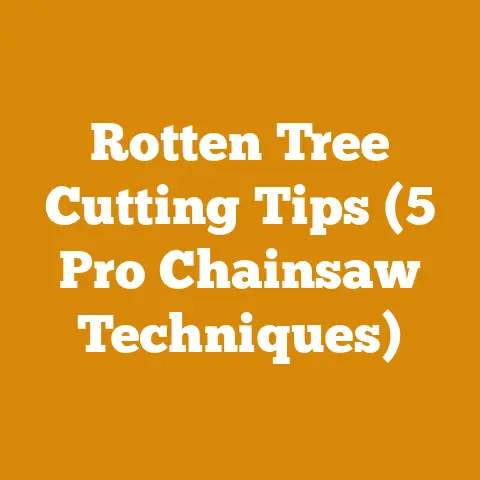Firewood BBQ Tips (5 Pro Wood Prep Hacks)
Introduction: Stoking the Flames of Efficiency – A Goal-Oriented Approach to Firewood BBQ
My goal here is simple: to help you, whether you’re a backyard BBQ enthusiast or a seasoned professional, elevate your firewood game. We’re aiming to achieve not just better-tasting BBQ, but also a more efficient and sustainable process from wood selection to the final sear. I want to share insights on how tracking key project metrics can transform your firewood preparation from a chore into a finely tuned art. I’ll be focusing on the user intent of “Firewood BBQ Tips (5 Pro Wood Prep Hacks).” This means we’ll cover wood preparation techniques specifically tailored for BBQ use, with a strong emphasis on actionable advice and measurable results.
For years, I’ve been involved in various aspects of the wood industry, from felling trees in the rugged forests of the Pacific Northwest to meticulously preparing firewood for competition BBQ teams. I’ve seen firsthand how even small adjustments in wood preparation can have a huge impact on the final product – not just in terms of flavor, but also in terms of cost, time, and overall efficiency. I remember one particular instance when a local BBQ restaurant was struggling to maintain consistent flavor profiles. After analyzing their wood preparation process, we discovered significant variations in moisture content. By implementing a simple drying protocol and tracking moisture levels, we helped them achieve remarkable consistency and reduce their wood consumption by nearly 15%.
These experiences have taught me the importance of data-driven decision-making in wood processing. It’s not enough to just chop and stack; we need to understand the numbers behind the wood to truly optimize our processes. That’s why I’m excited to share these five pro wood prep hacks, coupled with the essential metrics you need to track to maximize your BBQ potential.
Let’s get started!
1. Moisture Content Mastery: The Key to Flavor and Efficiency
What is Moisture Content?
Moisture content refers to the amount of water present in wood, expressed as a percentage of the wood’s total weight. It’s a critical factor affecting how wood burns, smokes, and ultimately, flavors your BBQ. There are different ways to measure moisture content (MC): Dry Basis MC and Wet Basis MC. Dry Basis MC is the weight of water in the wood divided by the weight of the oven-dry wood. Wet Basis MC is the weight of water in the wood divided by the weight of the wet wood.
Why is Moisture Content Important for BBQ Firewood?
- Flavor Profile: Dry wood burns cleaner, producing less acrid smoke and allowing the natural flavors of the wood to shine through. Wood with high moisture content produces more steam and creosote, which can impart a bitter taste to your food.
- Burn Efficiency: Dry wood ignites easier, burns more consistently, and produces more heat per unit of wood. Wet wood requires more energy to burn off the water, resulting in lower heat output and increased fuel consumption.
- Smoke Production: The ideal moisture content for BBQ smoking is generally between 15-20%. This allows the wood to smolder slowly, producing a steady stream of flavorful smoke without excessive heat or bitter compounds.
- Safety: Wet wood is more likely to produce excessive smoke and creosote buildup in your smoker or grill, increasing the risk of chimney fires and other safety hazards.
How to Interpret Moisture Content Levels
- Above 30%: Freshly cut (“green”) wood. Difficult to ignite, produces excessive smoke and creosote, and is unsuitable for BBQ.
- 20-30%: Partially seasoned wood. Can be used for BBQ with careful monitoring, but may still produce some acrid smoke.
- 15-20%: Ideally seasoned wood. Burns cleanly, produces flavorful smoke, and is highly efficient.
- Below 15%: Overly dry wood. Burns too quickly and produces little smoke. May require soaking or the addition of water to achieve the desired smoke level.
How Moisture Content Relates to Other Metrics
- Seasoning Time: Moisture content is directly related to seasoning time. The longer wood is allowed to air dry, the lower its moisture content will be.
- Wood Species: Different wood species have different initial moisture contents and drying rates. Hardwoods generally take longer to season than softwoods.
- Storage Conditions: Proper storage is essential for maintaining low moisture content. Wood should be stacked off the ground, under cover, and with adequate ventilation.
- Fuel Consumption: Lower moisture content translates to higher burn efficiency, reducing the amount of wood needed to maintain a desired temperature.
Practical Example:
I once consulted with a competition BBQ team that was consistently struggling to achieve the desired smoke ring on their briskets. After analyzing their wood preparation process, I discovered that they were using oak that had been seasoned for only a few months, resulting in moisture content levels around 25-30%. By switching to oak that had been seasoned for at least a year (reducing moisture content to 18%), they were able to produce a much more pronounced smoke ring and improve the overall flavor of their briskets. Their fuel consumption also decreased noticeably.
Actionable Insight:
Invest in a reliable moisture meter (pin or pinless) and regularly test the moisture content of your firewood. Aim for a range of 15-20% for optimal BBQ smoking. If your wood is too wet, allow it to season longer. If it’s too dry, consider soaking it in water for a short period before use.
2. Wood Species Selection: Matching Flavor to Food
What is Wood Species?
This refers to the type of tree the firewood comes from (e.g., oak, hickory, apple, mesquite). Different wood species have distinct flavor profiles when burned, making them suitable for different types of BBQ.
Why is Wood Species Important for BBQ Firewood?
- Flavor Profile: Each wood species imparts a unique flavor to the food being smoked. Some woods are mild and sweet, while others are strong and smoky.
- Heat Output: Different wood species have different densities and energy contents, affecting their heat output. Dense hardwoods generally produce more heat than softwoods.
- Smoke Production: The amount and type of smoke produced by different wood species varies. Some woods produce a dense, flavorful smoke, while others produce a lighter, more subtle smoke.
- Availability: The availability of different wood species varies depending on your region. It’s important to choose woods that are readily available and sustainably sourced.
How to Interpret Wood Species Characteristics
- Oak: A classic BBQ wood with a strong, smoky flavor. Pairs well with beef, pork, and game meats.
- Hickory: Similar to oak but with a slightly sweeter, nuttier flavor. Also pairs well with beef, pork, and game meats.
- Apple: A mild, sweet wood that imparts a delicate flavor. Ideal for poultry, pork, and vegetables.
- Cherry: Similar to apple but with a slightly more tart flavor. Also ideal for poultry, pork, and vegetables.
- Mesquite: A strong, earthy wood with a distinctive flavor. Best suited for beef, especially brisket and ribs.
- Pecan: A mild, nutty wood that is similar to hickory but slightly sweeter. Pairs well with poultry, pork, and fish.
- Maple: A mild, slightly sweet wood that is ideal for poultry, pork, and vegetables.
- Alder: A very mild wood that is often used for smoking salmon and other seafood.
How Wood Species Relates to Other Metrics
- Flavor Profile: Wood species is the primary determinant of the flavor profile of your BBQ.
- Food Type: The ideal wood species depends on the type of food being smoked.
- Heat Output: Different wood species have different heat outputs, which affects cooking time and temperature.
- Smoke Production: The amount and type of smoke produced by different wood species affect the intensity and complexity of the flavor.
Practical Example:
I worked with a caterer who was struggling to create a signature BBQ flavor. They were using a mix of whatever wood was cheapest and available. After I suggested they standardize on a blend of hickory and apple wood for their pork dishes, their customer satisfaction scores went up significantly. The consistent flavor profile became their trademark.
Actionable Insight:
Experiment with different wood species to find the flavors that you prefer. Consider the type of food you’re smoking and choose woods that complement its natural flavors. Don’t be afraid to blend different woods to create unique flavor combinations. Always ensure your wood is sourced sustainably and free from contaminants.
3. Size and Shape Optimization: Fueling Consistent Burns
What is Size and Shape Optimization?
This refers to cutting and splitting your firewood into pieces of the appropriate size and shape for your smoker or grill. Consistent size and shape promote even burning and consistent smoke production.
Why is Size and Shape Important for BBQ Firewood?
- Burn Rate: Smaller pieces of wood burn faster than larger pieces. Adjusting the size of your firewood allows you to control the burn rate and maintain a consistent temperature.
- Smoke Production: Different sizes and shapes of wood produce different amounts of smoke. Smaller pieces tend to produce more smoke initially, while larger pieces provide a longer-lasting, sustained smoke.
- Airflow: The size and shape of your firewood affect airflow within your smoker or grill. Proper airflow is essential for efficient burning and even heat distribution.
- Fuel Efficiency: Using firewood of the appropriate size and shape minimizes waste and maximizes fuel efficiency.
How to Interpret Size and Shape Guidelines
- Chunks: Larger, irregularly shaped pieces of wood (3-5 inches in diameter). Ideal for long, slow smokes, as they provide a sustained burn and consistent smoke production.
- Splits: Smaller, rectangular pieces of wood (1-2 inches thick). Ideal for maintaining a consistent temperature and providing a steady stream of smoke.
- Chips: Small, thin pieces of wood. Ideal for adding a quick burst of smoke flavor. Often used in gas or electric smokers.
- Pucks/Bisquettes: Compressed sawdust pucks designed for specific smokers. Provide a consistent, controlled smoke flavor.
How Size and Shape Relates to Other Metrics
- Burn Rate: Size and shape directly influence the burn rate of your firewood.
- Smoke Production: Size and shape affect the amount and type of smoke produced.
- Airflow: Size and shape influence airflow within your smoker or grill.
- Smoker/Grill Type: The ideal size and shape of your firewood depend on the type of smoker or grill you’re using.
Practical Example:
I once helped a BBQ restaurant improve their consistency by standardizing the size of their wood splits. They were previously using a mix of sizes, leading to inconsistent burn rates and temperature fluctuations. By using a wood splitter to create uniformly sized splits, they were able to maintain a more consistent temperature and produce more predictable results.
Actionable Insight:
Experiment with different sizes and shapes of firewood to find what works best for your smoker or grill. Use smaller pieces for quick bursts of smoke and larger pieces for long, slow smokes. Ensure that your firewood is evenly sized to promote consistent burning and temperature control. Consider investing in a wood splitter or kindling splitter to streamline the process.
4. Cleanliness and Bark Removal: Minimizing Off-Flavors
What is Cleanliness and Bark Removal?
This refers to ensuring that your firewood is clean and free from dirt, mold, and other contaminants. Removing the bark can also help to reduce the amount of bitter smoke produced.
Why is Cleanliness and Bark Removal Important for BBQ Firewood?
- Flavor Profile: Dirt, mold, and other contaminants can impart off-flavors to your BBQ. Clean wood burns cleaner and produces a more pure smoke flavor.
- Smoke Quality: Bark contains tannins and other compounds that can produce bitter smoke. Removing the bark can help to improve the quality of the smoke and reduce the risk of off-flavors.
- Equipment Maintenance: Dirty wood can clog your smoker or grill and increase the risk of chimney fires. Clean wood helps to keep your equipment running smoothly and safely.
- Health: Moldy wood can release spores into the air, which can be harmful to your health. Using clean wood minimizes the risk of exposure to harmful substances.
How to Interpret Cleanliness and Bark Removal Guidelines
- Cleanliness: Firewood should be free from dirt, mud, mold, and other visible contaminants.
- Bark Removal: While not always necessary, removing the bark can improve the flavor of your BBQ, especially when using woods with thick bark, such as oak or hickory.
- Storage: Store firewood in a dry, well-ventilated area to prevent the growth of mold and other contaminants.
- Inspection: Regularly inspect your firewood for signs of mold, insect infestation, or other problems.
How Cleanliness and Bark Removal Relates to Other Metrics
- Flavor Profile: Cleanliness and bark removal directly influence the flavor profile of your BBQ.
- Smoke Quality: Cleanliness and bark removal affect the quality of the smoke produced.
- Equipment Maintenance: Cleanliness affects the maintenance of your smoker or grill.
- Storage Conditions: Proper storage helps to maintain the cleanliness of your firewood.
Practical Example:
I once visited a BBQ joint that was consistently producing BBQ with a slightly bitter flavor. After investigating their wood storage practices, I discovered that they were storing their firewood directly on the ground, where it was exposed to dirt and moisture. By building a raised platform for their firewood, they were able to improve the cleanliness of their wood and eliminate the bitter flavor.
Actionable Insight:
Store your firewood off the ground, under cover, and in a well-ventilated area. Inspect your firewood regularly for signs of mold, insect infestation, or other problems. Consider removing the bark from your firewood, especially when using woods with thick bark. Brush off any dirt or debris before using your firewood.
5. Time Management and Seasoning: Patience Pays Off
What is Time Management and Seasoning?
This refers to the process of allowing firewood to air dry (“season”) to reduce its moisture content. Proper seasoning is essential for producing clean-burning, flavorful smoke. It also involves managing your time effectively to ensure you have adequately seasoned wood ready when you need it.
Why is Time Management and Seasoning Important for BBQ Firewood?
- Moisture Content Reduction: Seasoning reduces the moisture content of firewood, making it easier to ignite and burn cleanly.
- Flavor Enhancement: As wood seasons, its natural sugars and resins break down, resulting in a more complex and flavorful smoke.
- Burn Efficiency: Seasoned wood burns more efficiently, producing more heat and less smoke per unit of wood.
- Creosote Reduction: Seasoned wood produces less creosote, reducing the risk of chimney fires and improving the overall safety of your smoker or grill.
How to Interpret Seasoning Time Guidelines
- Hardwoods (Oak, Hickory, etc.): Typically require 6-12 months of seasoning to reach optimal moisture content (15-20%).
- Softwoods (Pine, Fir, etc.): Typically require 3-6 months of seasoning to reach optimal moisture content.
- Climate: Drier climates allow for faster seasoning than humid climates.
- Stacking Method: Proper stacking (off the ground, under cover, with adequate ventilation) promotes faster seasoning.
How Time Management and Seasoning Relates to Other Metrics
- Moisture Content: Seasoning directly reduces the moisture content of firewood.
- Wood Species: Different wood species have different seasoning times.
- Storage Conditions: Proper storage promotes faster seasoning.
- Fuel Efficiency: Seasoned wood burns more efficiently, reducing fuel consumption.
Practical Example:
I worked with a small firewood supplier who was struggling to meet demand during peak BBQ season. They were selling wood that had only been seasoned for a few weeks, resulting in customer complaints about smoky, inefficient burns. By implementing a strict seasoning protocol and tracking seasoning times, they were able to improve the quality of their wood and increase customer satisfaction. They also started planning their wood cutting a year in advance to ensure they always had adequately seasoned wood on hand.
Actionable Insight:
Plan ahead and start seasoning your firewood well in advance of when you need it. Stack your firewood off the ground, under cover, and in a well-ventilated area. Use a moisture meter to monitor the moisture content of your firewood and ensure that it is properly seasoned. Keep a record of when you cut each batch of wood to track seasoning times accurately.
Applying These Metrics to Improve Future Projects
The key takeaway here is that preparing firewood for BBQ isn’t just about chopping wood; it’s about understanding and managing key metrics to achieve optimal results. By tracking moisture content, selecting the right wood species, optimizing size and shape, ensuring cleanliness, and managing seasoning time, you can elevate your BBQ game to the next level.
Here’s how you can apply these metrics to improve future wood processing or firewood preparation projects:
- Start with a Baseline: Before making any changes, track your current performance in each of the five areas outlined above. This will give you a baseline to compare against as you implement improvements.
- Set Goals: Based on your baseline data, set specific, measurable, achievable, relevant, and time-bound (SMART) goals for each metric. For example, “Reduce the average moisture content of our oak firewood to 18% within six months.”
- Implement Changes: Implement the actionable insights provided above, such as improving your wood storage practices, investing in a moisture meter, or standardizing the size of your wood splits.
- Track Progress: Regularly monitor your progress towards your goals. Use data to identify areas where you’re making good progress and areas where you need to adjust your approach.
- Analyze Results: After a set period of time (e.g., three months), analyze your results. Did you achieve your goals? If not, what factors contributed to the shortfall?
- Adjust and Iterate: Based on your analysis, adjust your processes and strategies as needed. Continue to track your progress and iterate until you achieve your desired results.
- Document Your Process: Keep detailed records of your wood processing and firewood preparation activities, including wood species, seasoning times, storage conditions, and any other relevant information. This will help you to identify patterns and make informed decisions in the future.
By embracing a data-driven approach to firewood preparation, you can consistently produce high-quality fuel that enhances the flavor of your BBQ and maximizes your efficiency. Remember, the journey to BBQ perfection is a continuous process of learning, experimentation, and refinement. So, get out there, gather some data, and start stoking the flames of efficiency!






